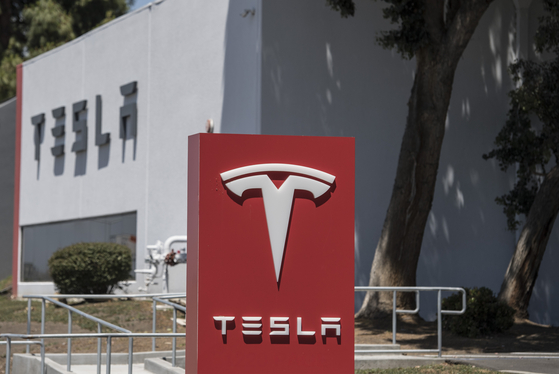[THINK ENGLISH] 전기차 판매 지난해 44.6% 급증

EV sales skyrocketed 44.6% last year
전기차 판매 지난해 44.6% 급증
Korea JoongAng Dail 3면 기사
Friday, March 12, 2021
Global sales of electric vehicles (EVs) rose by 44.6 percent last year despite the coronavirus pandemic.
skyrocket: 급등하다
electric vehicle(EV): 전기차
코로나19 팬데믹에도 불구하고 세계 전기차 판매량은 44.6%가 증가했다.
A total of 2.94 million EVs -- which includes pure-electric, plug-in hybrid and fuel cell cars -- were sold last year, according to data released by the Korean Automobile Manufacturers Association (KAMA) on Thursday.
pure-electric: 순수 전기차
fuel cell car: 수소차
plug-in hybrid: 플러그인 하이브리드. 전기 모터와 석유 엔진 둘 다 갖고 있는 차로 전기 모터의 전력이 다 소진 되었을 때, 석유 엔진이 작동한다.
한국자동차산업협회(KAMA)가 목요일 발표한 자료에 따르면 순수전기차와 플러그인 하이브리드와 수소차를 합친 전체 전기차는 지난해 294만대가 판매됐다.
Cars of all type recorded a 13.7 percent year-on-year sales drop last year, 80.9 million units compared to 93.7 million the year before.
year-on-year: 전년 대비의
지난해 자동차 판매는 전년에 비해 13.7%가 줄었다. 지난해 8090만대를 판매해 전년도 9370만대 보다 줄었다.
Tesla was still at the top of the EV game and Chinese EV market was the biggest. A total of 2.02 million pure-electric vehicles were delivered last year, a 34.7 percent year-on-year increase.
테슬라는 여전히 판매 1위를 차지했으며 중국 전기차 시장은 가장 큰 시장이었다. 202만대의 순수 전기차가 지난해 판매됐는데 이는 전년도에 비해 34.7% 상승한 것이다.
Plug-in hybrids sold 910,000 units, a 73.6 percent year-on-year jump, and fuel cell electric vehicles rose 9.3 percent on-year to reach 2,282 units.
플러그인 하이브리드는 91만대가 판매되며 전년도에 비해 73.6% 상승했다. 수소차는 9.3%가 늘어 2282대 판매됐다.
EVs accounted for 3.6 percent of all cars sold last year, compared to 2.2 percent in 2019.
account for: 설명하다, 차지하다
전기차는 지난해 판매된 자동차의 3.6%로 2019년 2.2%보다 높아진 수치다.
By country, China was the biggest market, absorbing 40.1 percent of all EVs sold last year. A total of 1.2 million EVs were sold in the country, a 14.7 percent year-on-year increase.
absorb: 흡수하다, 받아들이다
나라별로는 중국이 가장 큰 시장으로 지난해 판매된 전기차의 40.1%를 차지했다. 중국에서 판매된 전기차는 120만대로 전년에 비해 14.7%가 늘었다.
Germany was second with 404,545 units, a whopping 278.7 percent year-on-year jump, thanks to expanded state subsidies for EV purchases last year. France and Italy also upped their subsidies and sales expanded by 177.8 in France and 251.3 percent in Italy.
state subsidy: 정부 보조금
up: 올리다
expand: 확대하다
독일은 두 번째로 40만4545대가 판매됐다. 이는 전년에 비해 278.7%나 높아진 것으로 지난해 정부의 전기차 보조금이 확대된 덕분이었다. 프랑스와 이탈리아 역시 보조금을 높였고 덕분에 판매가 각각 177.8%, 251.3% 늘었다.
The United States came in third with 324,882 units sold, a 1 percent jump. Korea came in ninth selling 53,864 units, a 251.3 percent increase over 2019. Japan wasn’t included in the top 10 rankings.
미국은 세 번째로 32만4882대가 판매돼 1% 높아졌다. 한국은 9번째 판매국가로 5만3864대가 판매됐으며 이는 2019년에 비해 251.3% 높아진 것이다. 일본은 톱 10 국가에 포함되지 않았다.
By manufacturers, Tesla sold 442,334 units last year, rising 45.1 percent from the previous year and accounting for 15 percent of the global EV market.
제조사별로 테슬라는 지난해 전년에 비해 45.1% 늘어난 44만2334대를 판매해 세계 전기차 시장의 15%를 차지했다.
Volkswagen Group which includes Porsche, Audi and Volkswagen came in second selling 381,406 units, accounting for 13 percent of the market. With the launches of Volkswagen’s ID.3 and premium models like the Audi e-tron and Porsche Taycan, the German auto giant was able to post 211.1 percent yearly growth.
포르셰, 아우디, 폭스바겐 등을 판매하는 폭스바겐 그룹이 그 다음으로 38만1406대를 판매하며 13%의 시장점유율을 기록했다. 폭스바겐 ID.3과 아우디 이트론과 포르셰 타이칸 등을 출시함으로써 폭스바겐은 연간 성장률 211.1%를 기록할 수 있었다.
General Motors (GM) Group came in third with 221,116 units. The Hongguang Mini, which GM launched in China last year through a joint venture with SAIC Motor and Wuling, propelled the growth.
propel: 밀다, 나아가게 하다
GM 그룹은 21만1116대로 세 번째였다. 지난해 GM이 중국 상하이자동차와 중국 울링자동차와 합작회사를 통해 중국에 선보인 홍광 미니가 성장을 이끌었다.
Hyundai Motor Group, which includes Hyundai Motor and Kia, came in fourth, grabbing market share of 6.7 percent. It was expected to have sold 198,487 units last year, recording 59.9 percent year-on-year growth.
grab: 붙잡다
현대차와 기아를 합친 현대차그룹은 4번째로 시장 점유율 6.7%를 차지했다. 지난해 19만8487대를 판매하며 연간 성장률 59.9%를 기록했다.
By model, Tesla’s Model 3 was the most popular EV model last year, accounting for 16.6 percent of the market. Wuling’s Hongguang Mini came in second with 6 percent market share. Renault’s Zoe and Tesla’s Model Y claimed the third and fourth spots.
모델별로 테슬라의 모델3는 지난해 가장 인기 있는 전기차 모델로 시장 점유율 16.6%를 기록했다. 울링의 홍광 미니는 6%의 시장점유율로 2위를 차지했다. 르노의 조에와 테슬라의 모델Y는 각각 3위, 4위에 올랐다.
“The EV market in 2020 relied on state subsidies and incentives aimed at overcoming Covid-19,” said Jung Man-ki, chairman of KAMA, in a statement. “As much as EVs still lack competitiveness over internal combustion engines, expansions of subsidies and charging infrastructure are necessary.”
competitiveness: 경쟁력
internal combustion engine: 내연기관 엔진
KAMA의 정만기 회장은 “2020년 전기차 시장은 정부 보조금 확대 등 적극적인 인센티브 정책에 힘을 얻었다”며 “아직은 전기자동차가 내연기관차 대비 경쟁력을 확보하기 어려운 만큼 보조금 확대와 충전 인프라가 필요하다”고 말했다.
번역:박혜민 경제산업부장 [park.hyemin@joongang.co.kr]










with the Korea JoongAng Daily
To write comments, please log in to one of the accounts.
Standards Board Policy (0/250자)